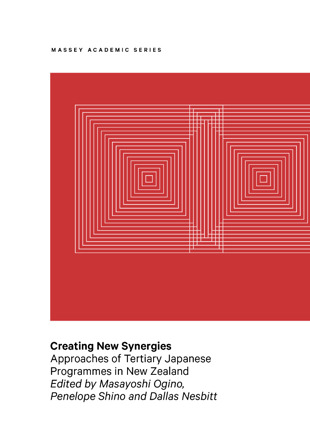PREFACE
This book aims to give an overview of how Japanese language education in the tertiary sector in New Zealand is reshaping its delivery and developing fresh relationships and synergies in order to adapt to the exceptional challenges, needs and opportunities arising in the new millennium.
The publication of the book is one of the projects of Japanese Studies Aotearoa New Zealand (JSANZ), the first advocacy network for Japanese language education and Japanese studies to be established at tertiary level in New Zealand. Prior to its formation in 2013, there was little networking, collaborative activity or research work occurring between tertiary institutions. The establishment of JSANZ was the result of a long-overdue need for a formal network that focuses on communication, collaboration and advocacy of Japanese language and Japanese studies in the tertiary sector.
The primary objective of this project is to provide readers with insights into how Japanese language educators are adapting twenty-first century pedagogical theory to enhance their students’ learning in New Zealand. Another objective is to enhance JSANZ’s policy of collaboration and cooperation among academics at tertiary institutions by sharing ideas on best practice, which is expected to promote and strengthen Japanese language education in New Zealand. The project also aims at helping stakeholders in various areas outside our programmes to better understand the problems we face in Japanese language education in this country, and consider further or alternative ways in which they might be able to support us in our work.
No book has ever been published on tertiary Japanese language education in New Zealand, so this is the very first and a pioneering book in that regard. The individual chapters by educators at the forefront of Japanese language teaching in New Zealand present innovative research,teaching strategies and practices, and explore practical ways of securing a healthy future for Japanese language education under the theme ‘creating new synergies’. The dialogue and collaboration that took place in the completion of this project have also created new synergies.
There are countries and regions which share similar issues and concerns to those we are dealing with in New Zealand, not least the decreasing number of learners of Japanese. Our approaches could be useful to them, and to other countries and regions that may face similar issues in the near future.
Our vision and hope is that this project will not finish with the publication of this book, but that it will inspire renewed interest in and new conversations about Japan and Japanese among educators and policy makers in New Zealand and beyond.
The nine chapters of the book are divided into three parts: Reflection and Renewal; Breaking Down the Walls; and Sharing Teaching Approaches.
As this is the very first book written about Japanese language education in New Zealand, an overview is an appropriate place to start. Some of the information about the beginnings of Japanese education have not been clearly documented; the first introductory chapter therefore plays the important role of being the ‘go to’ place for a brief history and outline of the changes which have taken place since the inception of Japanese language education in 1965. It also provides an overview of the current and future role and activity of JSANZ, and a glimpse of what the future might hold for JSANZ, for us as educators, and for our students. In Chapter 2, Ashton and Shino contribute to, and confirm, many aspects of the discussion of the issues facing Japanese language education presented in Chapter 1, by providing detailed data on the patterns of enrolment, continuation andcompletion of Japanese studies at Massey University, and interpreting the implications.
If our aim is to create a language-aware and language-proficient society, we need to make the process of language learning more visible and shared. Opening our schools and classrooms to others will strengthen the skills of our students by involving them in teaching and in building language communities, and it will provide rich opportunities for the creation of new synergies within our local communities. Ogino and Payne have acted decisively and proactively to change the situation where, as they confirm in Chapter 3, ‘tertiary institutions have rarely shared with the wider community’ (p. 93). They describe how the University of Canterbury holds an annual, large-scale Japanese workshop for secondary students facing national exams, and how the venture has resulted in a new type of learning community with close bonds, which are also created through an innovative mass dance project taking place alongside the workshop and shared through social media.
In Chapter 4, Kawai and Gallagher discuss how student work placements in local Japanese businesses foster student autonomy and a smoother transition between university and working life. Nishimura and Umeda, in Chapter 5, have brought community members right into their Japanese classes. They have found that Japanese language students benefit from the participation of members of the Japanese-speaking community, in this case young Japanese visitors to New Zealand, joining lessons and taking part in conversational tasks.
Most of us can picture a typical scene at a university. If we belong to an earlier generation it will probably include a lecturer speaking at length in front of a large lecture theatre of young people who are diligently taking notes. The term ‘lecturer’ has served well over the years to describe a person imparting knowledge to students, but, as the final four chapters make very clear, the nature of the job has changed. The numerous factors that have made Japanese language a less popular subject choice, along with a more diverse student body, have led to the reshaping of the typical Japanese class.
In Chapter 6, Minagawa highlights how Japanese television dramas, a medium attractive to many learners of Japanese, can be utilised to teach language as it is used in natural socio-cultural contexts, while building the students’ critical thinking skills. Kawai, Waller and Nesbitt describe in Chapter 7 how different-level Japanese language courses, which were unsustainable due to declining numbers, have been successfully combined and reconceptualised using a project-based approach. Their research indicates that students are developing greater intercultural competence, and that they find the mixed-level approach challenging as well as interesting and useful.
Tabata-Sandom has completed wide and very timely research on extensive reading for enjoyment in Japanese, which complements the usual intensive reading for study of Japanese grammar and vocabulary undertaken in most Japanese language classes. Her research, presented in Chapter 8, while confirming the value of reading for pleasure in terms of fluency and motivation development, also looks at the variety of reading which students are doing outside of class, and discusses strategies for choosing and including extensive reading materials in Japanese language courses.
Lawrence in Chapter 9 argues against stripping tertiary-level Japanese programmes completely of their traditional elements by showing how Classical Japanese language and literature can still be relevant, thanks to an innovative approach that emphasises the continuity between Classical and Modern Japanese.
Shaping the future and taking the best of New Zealand to the world has therefore never looked better. We are cautiously optimistic that the publication of this research will signal a new era in Japanese language education brought about by a connected and visionary team of educators and supporting groups.
Masayoshi Ogino, Penelope Shino and Dallas Nesbitt


